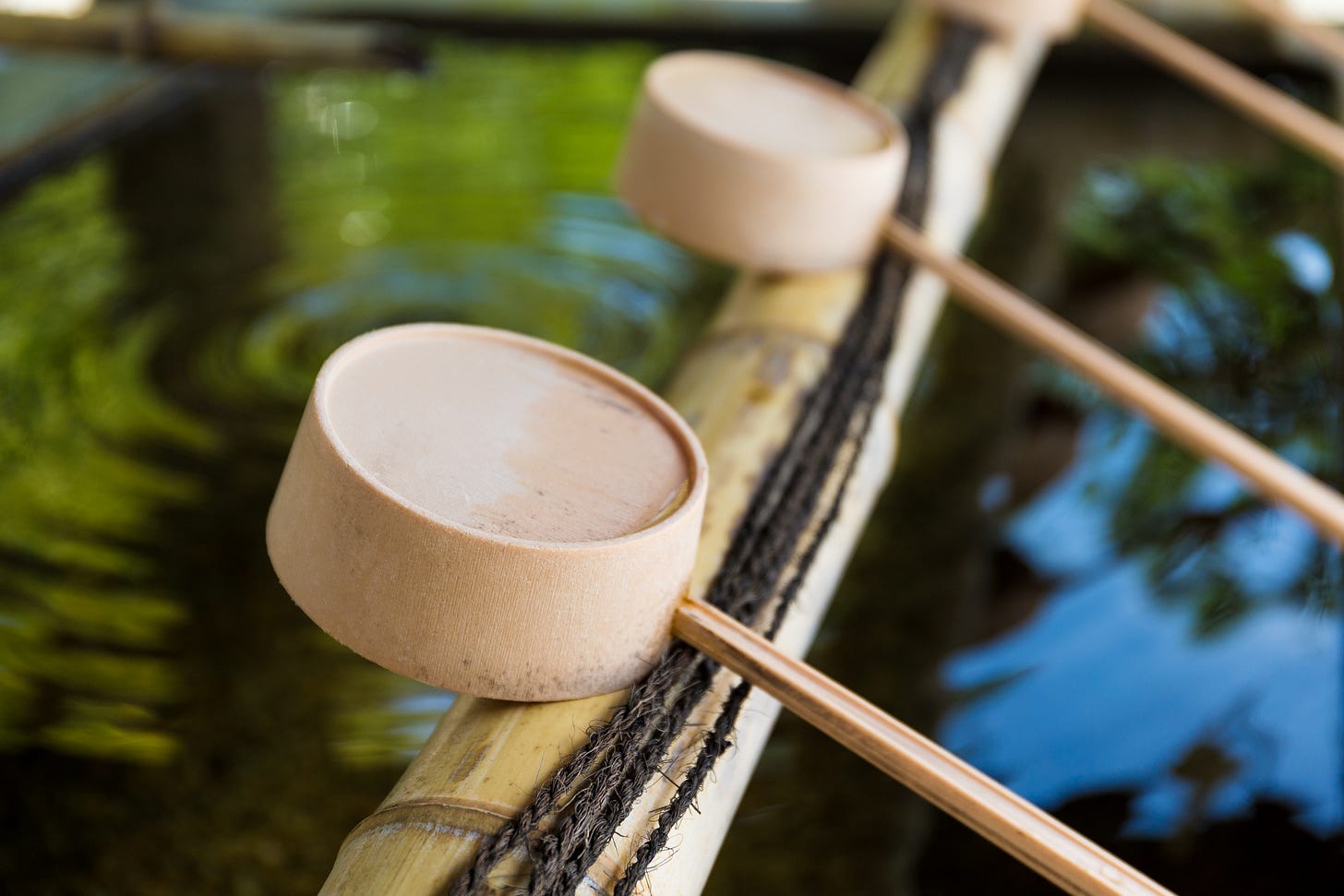Nudism without objects
Description

The wallpaper on my computer is a picture of the pool at a Japanese onsen, a bath house built around a natural hot spring. I’ve had this same picture set as my wallpaper through five or six different computers over the course of nearly twenty years at this point. So long that I’ve long ceased actually seeing it. I have no idea where in Japan the photograph was taken, who took it, or even where I first found it. It is has become, as the saying goes, just wallpaper.
Something prompted me recently to really look at this picture again. And, as is usually the case when you stop to really look at something that has been in your presence for years but you’ve stopped seeing, really looking at it again made me see things in it that I had never noticed before. In this case, how little information there is in the photograph for me to recognize it as having been taken in Japan.
The bottom half of the photo is mostly water. The top half is mostly rocks. There’s a building in the background that’s mostly concealed by trees, its main visible feature being a small window. On one of the rocks at the edge of the water sits a small wooden bucket.
I know very little about Japanese culture. I’ve read some Banana Yoshimoto, some Yukio Mishima, and I’ve seen my share of Kurosawa, but that’s about it. But, from the little I do know of Japan, the shape of that window and the shape of that bucket are enough for me to identify the culture this building belongs to and to know its intended use. And that that use involves social nudity.
I think the same would be true if you showed me a random picture of a sauna in Finland. Again, my knowledge of Finnish culture doesn’t extend much beyond Moomintroll and really comfortable socks, but I’m pretty sure I could recognize a Sauna and know that it’s in Finland just from a few visual clues in the architecture and the objects in the photo. And again, just from those objects, I would know that the use of that place involves social nudity.
Objects that signal nudity
Societies that have customs or activities that have evolved around social nudity have also almost invariably developed a material culture around those customs. Specific types of architecture and objects that are designed to facilitate the activity, and are also constructed in such a way that they express the attitudes, values, and personality of the culture that created them. In cultures where there are customs where nudity is normal, they make objects to enable those customs, and those objects are recognizable as objects from that culture.
Nudism in the English-speaking world doesn’t really have that. We tend to adapt existing structures to nudism by just being naked in them. Take all the people out, and a picture of a nudist swimming pool is going to look pretty much exactly like a picture of a non-nudist swimming pool.
A lot of this is an accident of history. Japan and Finland have had centuries to develop the material culture around social nudity. Nudism is a relatively young movement, and in America, it’s a young movement in a young country. And the period that nudism has emerged in has also been one of remarkable technological change that has reshaped many of the physical spaces where customs of social nudity might have developed in the Anglosphere. There were public bath houses in the US and the UK at the beginning of the 20th Century, but their use was largely ended with the spread of indoor plumbing and household water heaters. Without a widespread, ongoing custom of social nudity, a material culture around social nudity never developed. We never developed an American nudist bucket because we never had a social need for an American nudist bucket.
“We never developed an American nudist bucket because we never had a social need for an American nudist bucket.”
So does it really matter that there’s no object we can look at and say, “Well, that’s definitively an American nudist bucket”? I think it does, because I think asking that question opens up new ways to think about both the history and the future of nudism. Particularly, to think about the possibility of nudism as an aesthetic movement.
Aesthetics is a term that has been much abused lately. The past few years have had terms like Dark Academia, Coastal Grandmother, and Cybergoth thrown at us. There is even, God help us, an aesthetics wiki. It unfortunately seems that the pastime of placing anything and everything in as narrow a category as possible that’s consuming any part of the internet not already consumed by shouting at other people has come for the term. I’ve even heard someone describe something by saying “That’s so aesthetic” and another little piece of what’s left of my soul that hadn’t been killed off by Twitter died a little at that moment. Call it the Irritable Curmudgeon aesthetic.
From aesthetics to nudism
I think a more insightful use of the term can be found by looking back to the 19th Century, to Britain, and to the original Aesthetic movement. Aestheticism was an artistic and literary movement that evolved out of Romanticism, led by Oscar Wilde, Walter Pater, and Dante Gabriel Rossetti, among others. The core idea was that art should not primarily seek to be didactic or moralistic, but beautiful solely for the sake of beauty. Art for art’s sake is a term that comes directly from this movement. In the Aesthetic view, moral good could and would arise from surrounding oneself with beauty, and developing the critical judgment to embrace and appreciate beauty.
Beauty for beauty’s sake does have the problem that you can have all the beauty you want, but you’ll still need something to sit on. So a more practical outgrowth of the Aesthetic movement came from William Morris and his Arts and Crafts movement, which was dedicated to the idea that everyday objects should be beautiful for everyone. You not only need something to sit on, you need something beautiful to sit on. The underlying philosophical position of the Aesthetic movement and its outgrowths was that the human soul requires a deep experience with beauty to be complete.
All of this happened in large part as a reaction to the mass industrialization of 19th-century Britain. Morris, in particular, was repelled by the ravages of pollution and the way industrialization consumed individuals and devastated entire communities. His vision was one of encouraging the continued development of traditional arts and crafts, reaffirming the dignity of labor, and reconnecting with nature. As a project, it was somewhat curtailed when the leadership of Europe decided that being slaughtered on the fields of Flanders was a better social use for a substantial portion of those traditional craftsmen than making chairs, but philosophically, Morris’ ideas remained influential.
For those of you knowledgeable about the history of nudism, you may note a distinct similarity between many of the motivations of and philosophies around nudism and Morris’s philosophy. And I think you’re right to notice that. I would even go so far as to say that nudism was one of those outgrowths of the Aesthetic movement.
Which brings me back to that American nudist bucket. If such an object existed, what would it look like? Because it shouldn’t be the same as that Japanese bucket. Or a Finnish bucket. The material culture around nudity in Finland is different than the material culture of nudity in Japan, because they are the products of different cultures. And if there is to be a material culture of American nudism, it should look different than both of those, but also look different from the materia





